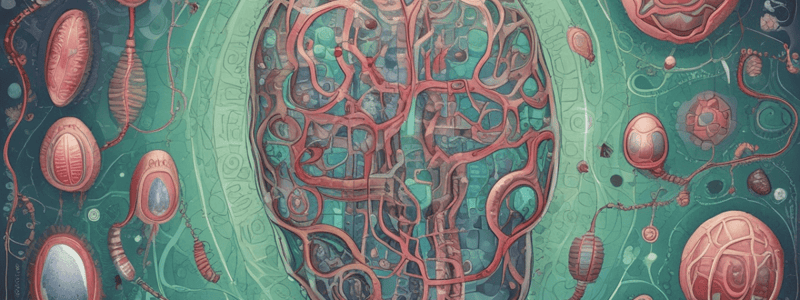Podcast
Questions and Answers
What is the main function of mitochondria in cells?
What is the main function of mitochondria in cells?
- To regulate body temperature
- To store genetic information
- To convert food into energy (correct)
- To convert energy into food
What is the term used to refer to mitochondrial disease?
What is the term used to refer to mitochondrial disease?
- Mitochondrial dysfunction
- Energy deficiency
- Mito (correct)
- Organ failure
What is the current status of a cure for mitochondrial disease?
What is the current status of a cure for mitochondrial disease?
- There is no cure (correct)
- There is a cure available
- The cure is only available for mild cases
- A cure is being developed
What is the purpose of mitochondrial donation?
What is the purpose of mitochondrial donation?
What is the estimated prevalence of mitochondrial disease in the general population?
What is the estimated prevalence of mitochondrial disease in the general population?
What is the typical outcome of mitochondrial disease that manifests in childhood?
What is the typical outcome of mitochondrial disease that manifests in childhood?
How many babies born each year in Australia are likely to develop life-threatening mitochondrial disease?
How many babies born each year in Australia are likely to develop life-threatening mitochondrial disease?
What is the source of faulty genes that cause mitochondrial disease?
What is the source of faulty genes that cause mitochondrial disease?
What is the primary goal of mitochondrial donation?
What is the primary goal of mitochondrial donation?
What is the role of the intending parents in mitochondrial donation?
What is the role of the intending parents in mitochondrial donation?
What is the name of the law that makes mitochondrial donation legal in Australia?
What is the name of the law that makes mitochondrial donation legal in Australia?
What is the purpose of the preclinical research and training program?
What is the purpose of the preclinical research and training program?
What is the source of frozen eggs for the preclinical research and training program?
What is the source of frozen eggs for the preclinical research and training program?
What is the expected outcome for children born after mitochondrial donation?
What is the expected outcome for children born after mitochondrial donation?
What is the purpose of the mitoHOPE program?
What is the purpose of the mitoHOPE program?
What is the requirement for clinics to perform mitochondrial donation?
What is the requirement for clinics to perform mitochondrial donation?
What is the expected timeline for enrolling participants in the clinical trial?
What is the expected timeline for enrolling participants in the clinical trial?
What is the role of the egg donor in mitochondrial donation?
What is the role of the egg donor in mitochondrial donation?
Study Notes
Mitochondrial Disease (Mito)
- Mitochondrial disease is a group of conditions that affect the ability of cells to generate energy, leading to organ failure.
- There are two types of mitochondrial disease: one caused by faulty genes in nuclear DNA and the other caused by faulty genes in mitochondrial DNA.
- Mitochondrial disease is the most common inherited metabolic condition, affecting one in 5,000 people.
- Symptoms can be mild and progress slowly, or severe and progress rapidly.
- Organs that need a lot of energy, such as the brain, muscle, and heart, are more often affected.
Mitochondrial Donation
- Mitochondrial donation is an experimental IVF-based technique that allows people with faulty mitochondrial DNA to have genetically related children without passing on the faulty DNA.
- The technique involves removing the nuclear DNA from the egg of someone with faulty mitochondrial DNA and inserting it into a healthy egg donated by someone not affected by mito.
- The resulting egg has the nuclear DNA of the intending parents and functioning mitochondria from the donor.
- A child born after mitochondrial donation will have genetic material from three parties: nuclear DNA from the intending parents and mitochondrial DNA from the egg donor.
Maeve's Law
- Maeve's Law is a law passed in the Australian Senate in 2022, making mitochondrial donation legal in a research and clinical trial setting.
- The law stipulates strict conditions, including the need for clinics to have a special licence to perform mitochondrial donation.
- Initial licences will be issued for pre-clinical and clinical trial research and training to ensure mitochondrial donation is safe and effective.
Mitochondrial Donation in Australia
- Scientists are preparing for a clinical trial to test the safety and effectiveness of mitochondrial donation.
- The mitoHOPE (Healthy Outcomes Pilot and Evaluation) program will perfect the technique and conduct a clinical trial.
- A preclinical research and training program will ensure embryologists are trained in "real-life" clinical conditions and existing mitochondrial donation techniques are refined and improved.
Need for Donor Eggs
- Sourcing eggs is a challenge for mitochondrial donation.
- Frozen eggs can be used for preclinical research and training, but "fresh" eggs will be needed for the clinical trial.
- Research suggests that people with stored eggs may be willing to donate them to mitochondrial donation preclinical research.
- Volunteer egg donors will be needed for the clinical trial to provide people affected by mito with a chance to have a healthy baby.
Studying That Suits You
Use AI to generate personalized quizzes and flashcards to suit your learning preferences.
Description
Learn about mitochondrial disease, its effects on the body, and the hope offered by mitochondrial donation, a new IVF procedure.



